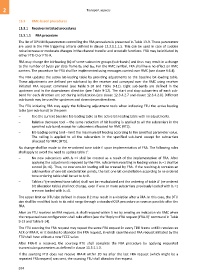Page 984 - 5G Basics - Core Network Aspects
P. 984
2 Transport aspects
13.3 RMC-based procedures
13.3.1 Receiver initiated procedures
13.3.1.1 FRA procedure
The list of DPU-MIB parameters controlling the FRA procedure is presented in Table 13-9. These parameters
are used in the FRA triggering criteria defined in clause 13.3.1.1.1.5. This can be used in case of sudden
noise increase or moderate changes in the channel transfer and crosstalk functions. FRA may be initiated by
either FTU-O or FTU-R.
FRA may change the bit-loading (bi) of some subcarrier groups (sub-bands) and thus may result in a change
to the number of bytes per data frame BD and BDR. For the RMC symbol, FRA shall have no effect on RMC
carriers. The procedure for FRA shall be implemented using messages carried over RMC (see clause 9.6.4).
The FRA updates the active bit-loading table by providing adjustments to the baseline bit-loading table.
These adjustments are defined per sub-band by the receiver and conveyed over the RMC using receiver
initiated FRA request command (see Table 9-10 and Table 9-11). Eight sub-bands are defined in the
upstream and in the downstream direction (see Table 9-12). The start and stop subcarriers of each sub-
band for each direction are set during initialization (see clause 12.3.4.2.7 and clause 12.3.4.2.8). Different
sub-bands may be used for upstream and downstream directions.
The FTU initiating FRA may apply the following adjustment tools when indicating FTU the active loading
table (per sub-band) to the peer:
– Use the current baseline bit-loading table as the active bit-loading table with no adjustments.
– Relative decrease tool – the same reduction of bit loading is applied to all the subcarriers in the
specified sub-band, except for subcarriers allocated for RMC (RTS).
– Bit-loading ceiling tool – limit the maximum bit loading according to the specified parameter value.
The ceiling is applied to all the subcarriers in the specified sub-band except for subcarriers
allocated for RMC (RTS).
No change shall be made to the re-ordered tone table t' upon implementation of FRA. The following rules
shall apply to avoid the need to update table t':
– No new subcarriers with bi =1 shall be created as a result of the implementation of FRA. After
applying the adjustments required by the FRA, subcarriers resulting in loading values bi =1 shall be
zeroed (bi =0). Thus, no new one-bit loading will be created by FRA. If the resulting bi contains an
odd number of one-bit constellation points, the last one-bit constellation according to re-ordered
tone ordering table shall be set to bi=0.
– Tables t' (re-ordered tone table) shall not be recalculated and the ordering of table b' (re-ordered
bit allocation table) shall not change, even if one or more subcarriers previously loaded with bi =1
are now loaded with bi =0.
The upper limit on DTU size defined in clause 8.2 may result in a violation after a FRA. In this case, the DTU
size shall be modified back to its valid range through a standard OLR procedure as soon as possible after the
FRA.
After an FTU receives an FRA request, it shall respond within 5 ms by sending an indication via RMC when
the requested new configuration shall take effect (see the 'Reply to FRA request (FRA-R)' command in Table
9-13 and Table 9-14).
The FTU sourcing the FRA request may repeat the same FRA request in every TDD frame until it receives an
ACK or FRA-R, or it decides to abandon the FRA request, in which case the next FRA request initiated by the
FTU shall have at least a new FCCC value.
After FRA-R is received, the sourcing FTU shall complete the FRA procedure by applying requested
transmission parameters as defined in clause 13.3.1.1.3.
If the sourcing FTU does not receive FRA-R within 20 ms after the last FRA request (which might be a
repeated FRA request) was sent, the sourcing FTU shall abandon the request.
974

